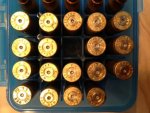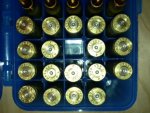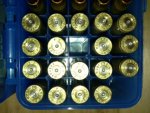Ive been hand loading for bolt actions for quite some time, but recently I built a AR-15, with a 24" ER shaw bull barrel (Model 1 sales upper).
Chambered in . 223 Rem., So Im somewhat new to loading for a semi.
I worked up a great load with Nosler 55gn Armageddon bullets with 26.5gn of CFE-223. Great load, shoots very well, no pressure signs at all.
Then I began my workup with the Nosler 69gn HPBT Custom Competition bullet.
CCI -400 primers
CFE-223
Federal Brass
OAL of 2.255"
Sized Headspace: 1.452"
Fired Fomed Headspace after workup: 1.460"
Obviously too much shoulder bump, which was unintentional. How far should I bump the shoulder on these cases for a semi auto? .005".
On my bolt rifles I only bump the shoulder back .002".
I use OCW for load development so I loaded 25 cartridges at 5 different charge weights:
23.5gn
24
24.5
25
25.5
While working up my chronograph had a error that I wasn't able to fix until I get home.
But after shooting the 5 at 25gn my primers seemed really flattened.
My initial thought was that it may be due to the fact that I used the chamfer tool to remove the military crimp, in doing so it leaves a slight countersink into the primers pocket, so possibly the primers where flattening because they were filling in that countersink/recess. I immediately stopped at 25gn and called it a day.
My question is do these pictures attached of each charge weight look like they are over pressured?
I'm within the Hodgdon load data and Quickload is saying that 25.5 grains is only 53,000psi, plenty below Pmax.
Please see attached pictures and let me know if you think I'm seeing pressure signs.
The bottom row is 23.5gn and each row up increases by .5 up to the 25.0gn that I stopped at.
Any opinions appreciated.
Thanks,
Ryan
Chambered in . 223 Rem., So Im somewhat new to loading for a semi.
I worked up a great load with Nosler 55gn Armageddon bullets with 26.5gn of CFE-223. Great load, shoots very well, no pressure signs at all.
Then I began my workup with the Nosler 69gn HPBT Custom Competition bullet.
CCI -400 primers
CFE-223
Federal Brass
OAL of 2.255"
Sized Headspace: 1.452"
Fired Fomed Headspace after workup: 1.460"
Obviously too much shoulder bump, which was unintentional. How far should I bump the shoulder on these cases for a semi auto? .005".
On my bolt rifles I only bump the shoulder back .002".
I use OCW for load development so I loaded 25 cartridges at 5 different charge weights:
23.5gn
24
24.5
25
25.5
While working up my chronograph had a error that I wasn't able to fix until I get home.
But after shooting the 5 at 25gn my primers seemed really flattened.
My initial thought was that it may be due to the fact that I used the chamfer tool to remove the military crimp, in doing so it leaves a slight countersink into the primers pocket, so possibly the primers where flattening because they were filling in that countersink/recess. I immediately stopped at 25gn and called it a day.
My question is do these pictures attached of each charge weight look like they are over pressured?
I'm within the Hodgdon load data and Quickload is saying that 25.5 grains is only 53,000psi, plenty below Pmax.
Please see attached pictures and let me know if you think I'm seeing pressure signs.
The bottom row is 23.5gn and each row up increases by .5 up to the 25.0gn that I stopped at.
Any opinions appreciated.
Thanks,
Ryan
Attachments
Last edited:




